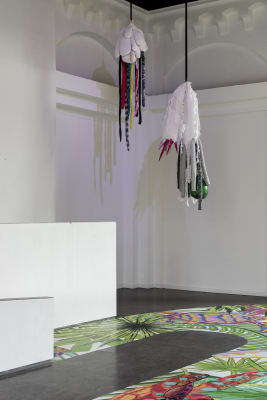Hi Ventilation, show me your winding winds and breathe some air into the corners! Let’s pretend we’re trains, let’s roll together, let‘s train surf and challenge structures, let’s find fresh air and free spaces!
During play, relationships can be shifted and reversed; social bonds and new ideas can emerge during free experimentation. During the dark times of 1938, Johan Huizinga formulated his idea of the "Homo Ludens"—the playing human being at the origin of culture—and defended the opening of possibilities in narrow times. In reflecting on what a Kunstverein can be, we wish to build upon this term with this exhibition: because to make a difference, we have to keep moving.
Movement, physical experience, and challenging norms are central to the work of assume vivid astro focus (avaf). For the 2004 Whitney Biennale, they built their first roller skating rink in New York’s Central Park as a tribute to the local roller skating community. Their aim was to set people into motion and give them space to express themselves on the ground offered by art, thus bringing about change. To celebrate our anniversary, we are delighted that avaf have designed a site-specific roller skating rink for the Kunstverein, making extensive reference to the former colonial architecture and history of the waiting room at Harburger Bahnhof. To mark the anniversary, you can explore the Kunstverein’s exhibition hall with or without roller skates and glide through a panorama full of botanical and animistic border crossings and challenges, with new works by Melissa E. Logan (born 1970 in New York, lives in Hamburg), David Reiber Otálora (born 1992 in Münster, lives in Berlin), Niclas Riepshoff (born 1992 in Bremen, lives in Berlin), Aleen Solari (born 1980 in Bielefeld, lives in Hamburg), Hoda Tawakol (born 1968 in London, lives in Hamburg), and Alison Yip (born in Calgary, lives in Brussels).
This panorama is contrasted by the sculpture Humpty Dumpty by Fion Pellacini (born 1986, lives in Hamburg), a to-scale reproduction of an Eton Fives playing field. Eton Fives is a niche British sport that was created in the 19th century. It originated on the outside wall of the chapel at Eton College and is played against the wall with the bare hand and a ball at boarding schools all over the world. Its very specific playing-field architecture can be understood as an image of asymmetrical conditions. Like a diorama, it invites us to renegotiate them as a kind of spatial symbolism. The Eton Fives Court at the Kunstverein is thus available as an exhibition space within the exhibition space throughout the fall for the weekly changing Five in Fives series of exhibitions, opening every Wednesday. The series negotiates issues connected with the structure of an art association, Kunstverein: games, the body, networks, gardens, and the train that will carry us and our association forward into the next 20 years!
